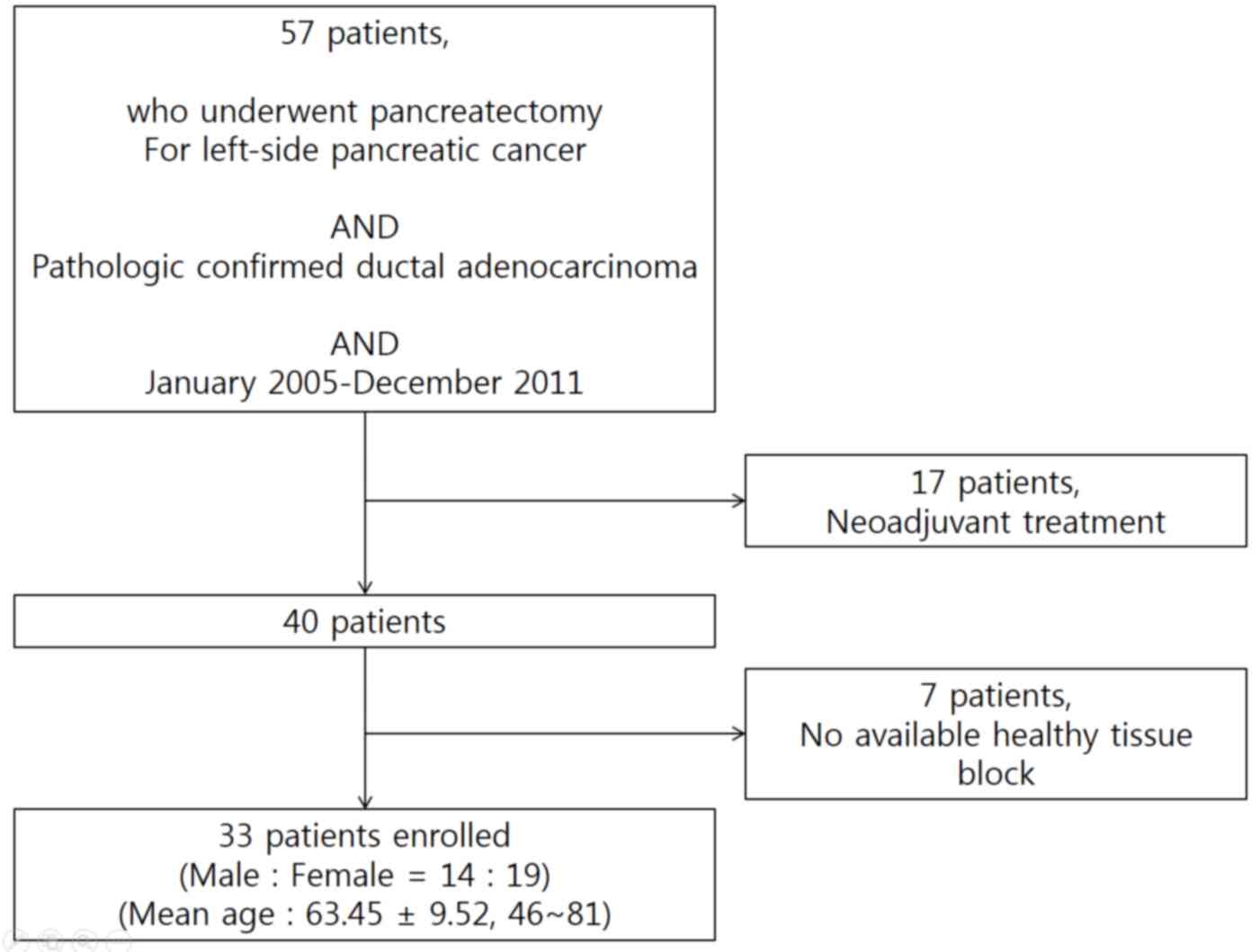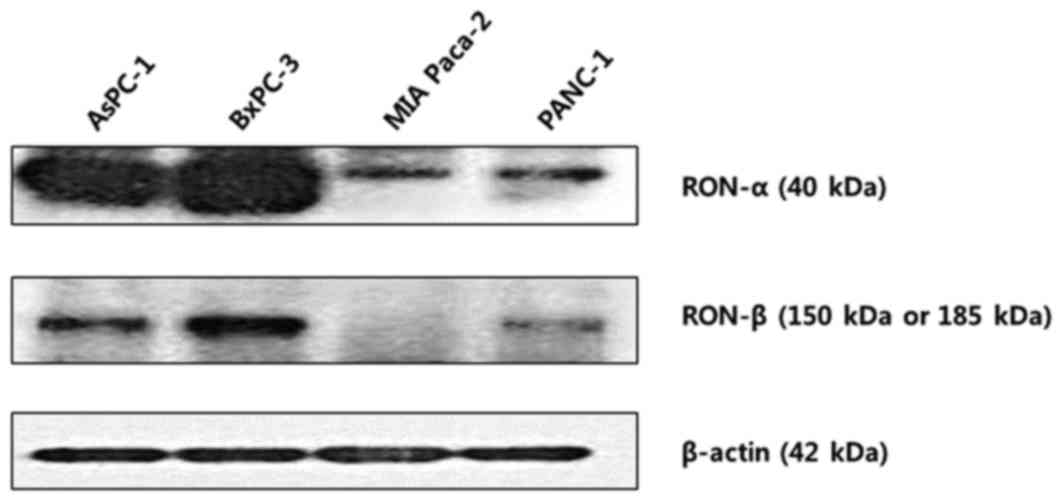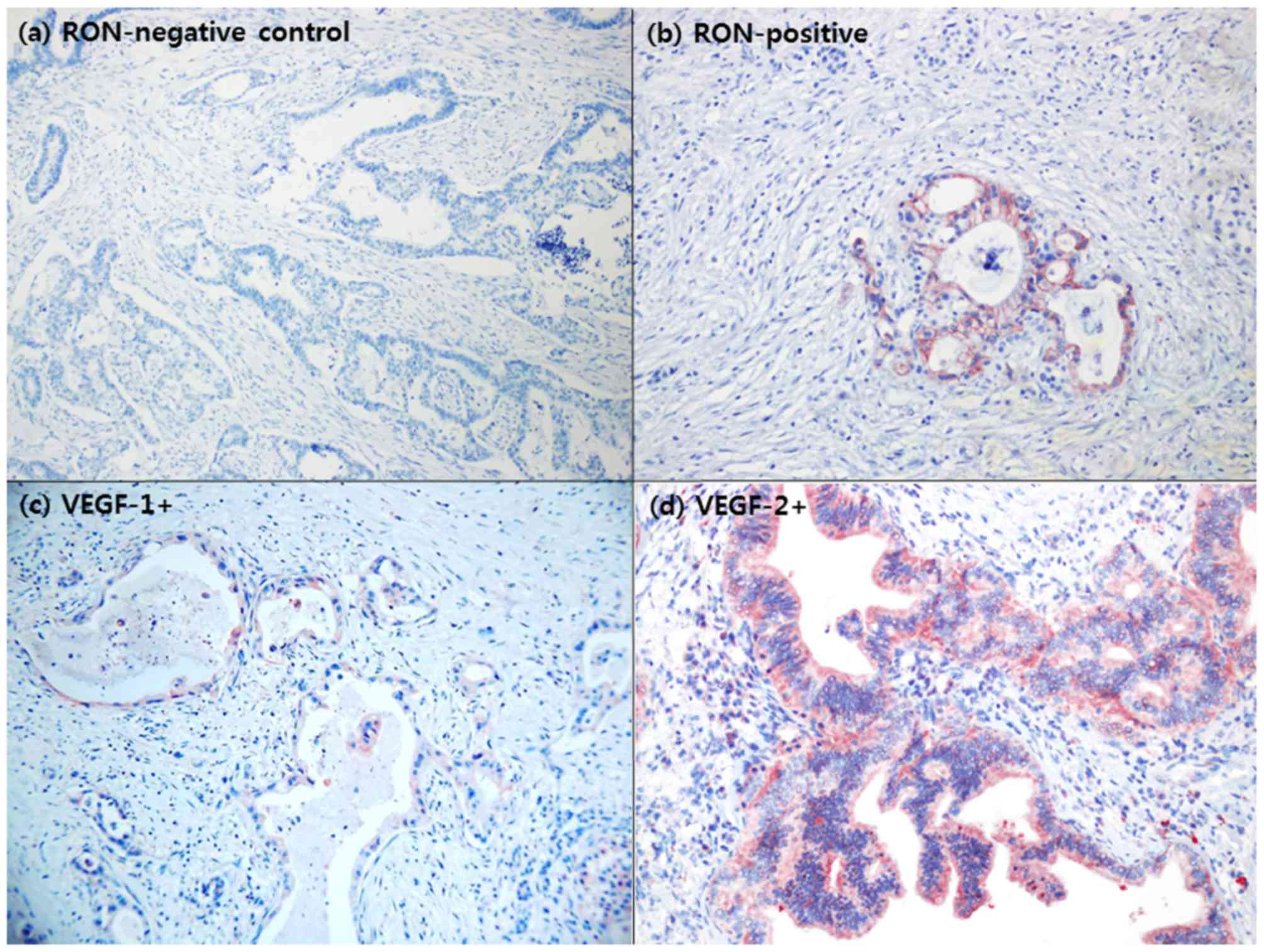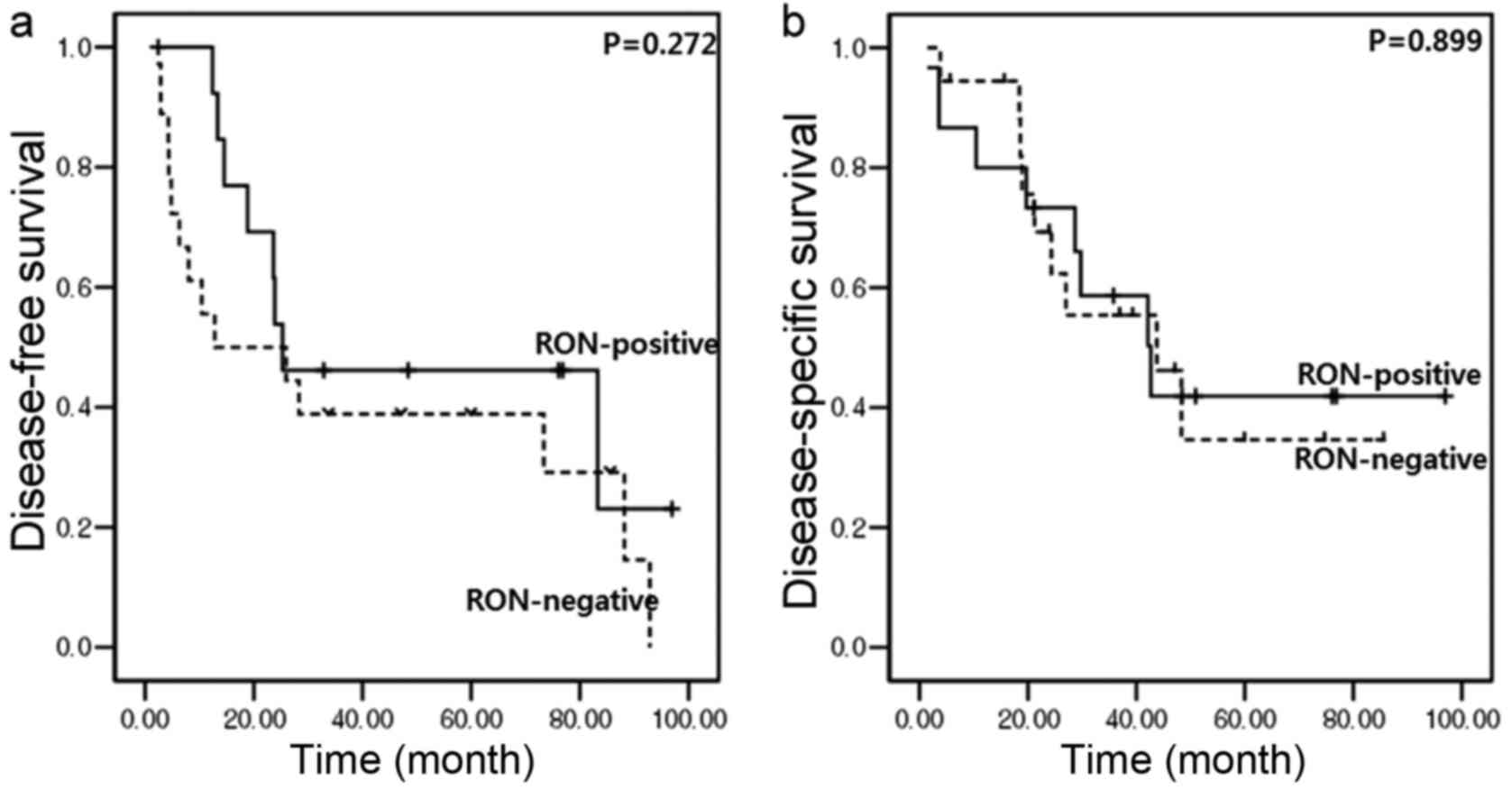|
1
|
Ronsin C, Muscatelli F, Mattei MG and
Breathnach R: A novel putative receptor protein tyrosine kinase of
the met family. Oncogene. 8:1195–1202. 1993.PubMed/NCBI
|
|
2
|
Park M, Dean M, Kaul K, Braun MJ, Gonda MA
and Vande Woude G: Sequence of MET protooncogene cDNA has features
characteristic of the tyrosine kinase family of growth-factor
receptors. Proc Natl Acad Sci USA. 84:6379–6383. 1987. View Article : Google Scholar : PubMed/NCBI
|
|
3
|
Wang MH, Wang D and Chen YQ: Oncogenic and
invasive potentials of human macrophage-stimulating protein
receptor, the RON receptor tyrosine kinase. Carcinogenesis.
24:1291–1300. 2003. View Article : Google Scholar : PubMed/NCBI
|
|
4
|
Wang MH, Ronsin C, Gesnel MC, Coupey L,
Skeel A, Leonard EJ and Breathnach R: Identification of the ron
gene product as the receptor for the human macrophage stimulating
protein. Science. 266:117–119. 1994. View Article : Google Scholar : PubMed/NCBI
|
|
5
|
Lee WY, Chen HH, Chow NH, Su WC, Lin PW
and Guo HR: Prognostic significance of co-expression of RON and MET
receptors in node-negative breast cancer patients. Clin Cancer Res.
11:2222–2228. 2005. View Article : Google Scholar : PubMed/NCBI
|
|
6
|
Lee CT, Chow NH, Su PF, Lin SC, Lin PC and
Lee JC: The prognostic significance of RON and MET receptor
coexpression in patients with colorectal cancer. Dis Colon Rectum.
51:1268–1274. 2008. View Article : Google Scholar : PubMed/NCBI
|
|
7
|
Song YA, Park YL, Kim KY, Myung E, Chung
CY, Cho SB, Lee WS, Jung YD, Kweon SS and Joo YE: RON is associated
with tumor progression via the inhibition of apoptosis and cell
cycle arrest in human gastric cancer. Pathol Int. 62:127–136. 2012.
View Article : Google Scholar : PubMed/NCBI
|
|
8
|
Han WL, Li WD, Hu J, Rusidanmu A, Chen LF,
Shen L and Zheng SS: Expression of the recepteur d'originenantais
receptor tyrosine kinase in non-small cell lung cancer and its
clinical significance. Chin Med J (Engl). 125:1110–1114.
2012.PubMed/NCBI
|
|
9
|
Cheng HL, Liu HS, Lin YJ, Chen HH, Hsu PY,
Chang TY, Ho CL, Tzai TS and Chow NH: Co-expression of RON and MET
is a prognostic indicator for patients with transitional-cell
carcinoma of the bladder. Br J Cancer. 92:1906–1914. 2005.
View Article : Google Scholar : PubMed/NCBI
|
|
10
|
Ferrandina G, Martinelli E, Petrillo M,
Prisco MG, Zucconi A, Santaguida S, Zannoni G, Scambia G and
Ferlini C: Prognostic role of the recepteur d'origine nantais (RON)
expression in ovarian cancer patients. Gynecol Oncol. 111:237–243.
2008. View Article : Google Scholar : PubMed/NCBI
|
|
11
|
Kang CM, Babicky ML and Lowy AM: The RON
receptor tyrosine kinase in pancreatic cancer pathogenesis and its
potential implications for future targeted therapies. Pancreas.
43:183–189. 2014. View Article : Google Scholar : PubMed/NCBI
|
|
12
|
Camp ER, Yang A, Gray MJ, Fan F, Hamilton
SR, Evans DB, Hooper AT, Pereira DS, Hicklin DJ and Ellis LM:
Tyrosine kinase receptor RON in human pancreatic cancer:
Expression, function, and validation as a target. Cancer.
109:1030–1039. 2007. View Article : Google Scholar : PubMed/NCBI
|
|
13
|
Babicky ML, Maruyama K, Jaquish D and
French R: RON overexpression accelerates tumorigenesis and induces
metastasis in a KRAS mutant mouse model of pancreatic cancer. J Am
Coll Surg. 213:(Suppl). S1312011. View Article : Google Scholar
|
|
14
|
Thomas RM, Toney K, Fenoglio-Preiser C,
Revelo-Penafiel MP, Hingorani SR, Tuveson DA, Waltz SE and Lowy AM:
The RON receptor tyrosine kinase mediates oncogenic phenotypes in
pancreatic cancer cells and is increasingly expressed during
pancreatic cancer progression. Cancer Res. 67:6075–6082. 2007.
View Article : Google Scholar : PubMed/NCBI
|
|
15
|
Kalluri R: EMT: When epithelial cells
decide to become mesenchymal-like cells. J Clin Invest.
119:1417–1419. 2009. View
Article : Google Scholar : PubMed/NCBI
|
|
16
|
Kalluri R and Weinberg RA: The basics of
epithelial-mesenchymal transition. J Clin Invest. 119:1420–1428.
2009. View
Article : Google Scholar : PubMed/NCBI
|
|
17
|
Hermann PC, Huber SL, Herrler T, Aicher A,
Ellwart JW, Guba M, Bruns CJ and Heeschen C: Distinct populations
of cancer stem cells determine tumor growth and metastatic activity
in human pancreatic cancer. Cell Stem Cell. 1:313–323. 2007.
View Article : Google Scholar : PubMed/NCBI
|
|
18
|
Jaquish DV, Yu PT, Shields DJ, French RP,
Maruyama KP, Niessen S, Hoover HA, Cheresh D, Cravatt B and Lowy
AM: IGF1-R signals through the RON receptor to mediate pancreatic
cancer cell migration. Carcinogenesis. 32:1151–1156. 2011.
View Article : Google Scholar : PubMed/NCBI
|
|
19
|
Rajeshkumar NV, Rasheed ZA, Garcia-Garcia
E, López-Rios F, Fujiwara K, Matsui WH and Hidalgo M: A combination
of DR5 agonistic monoclonal antibody with gemcitabine targets
pancreatic cancer stem cells and results in long-term disease
control in human pancreatic cancer model. Mol Cancer Ther.
9:2582–2592. 2010. View Article : Google Scholar : PubMed/NCBI
|
|
20
|
Peace BE, Toney-Earley K, Collins MH and
Waltz SE: Ron receptor signaling augments mammary tumor formation
and metastasis in a murine model of breast cancer. Cancer Res.
65:1285–1293. 2005. View Article : Google Scholar : PubMed/NCBI
|
|
21
|
Thomas RM, Jaquish DV, French RP and Lowy
AM: The RON tyrosine kinase receptor regulates vascular endothelial
growth factor production in pancreatic cancer cells. Pancreas.
39:301–307. 2010. View Article : Google Scholar : PubMed/NCBI
|
|
22
|
Padhye SS, Guin S, Yao HP, Zhou YQ, Zhang
R and Wang MH: Sustained expression of the RON receptor tyrosine
kinase by pancreatic cancer stem cells as a potential targeting
moiety for antibody-directed chemotherapeutics. Mol Pharm.
8:2310–2319. 2011. View Article : Google Scholar : PubMed/NCBI
|
|
23
|
Camp ER, Liu W, Fan F, Yang A, Somcio R
and Ellis LM: RON, a tyrosine kinase receptor involved in tumor
progression and metastasis. Ann Surg Oncol. 12:273–281. 2005.
View Article : Google Scholar : PubMed/NCBI
|
|
24
|
Logan-Collins J, Thomas RM, Yu P, Jaquish
D, Mose E, French R, Stuart W, McClaine R, Aronow B, Hoffman RM, et
al: Silencing of RON receptor signaling promotes apoptosis and
gemcitabine sensitivity in pancreatic cancers. Cancer Res.
70:1130–1140. 2010. View Article : Google Scholar : PubMed/NCBI
|
|
25
|
Chakedis J, French R, Babicky M, Jaquish
D, Howard H, Mose E, Lam R, Holman P, Miyamoto J, Walterscheid Z
and Lowy AM: A novel protein isoform of the RON tyrosine kinase
receptor transforms human pancreatic duct epithelial cells.
Oncogene. 35:3249–3259. 2016. View Article : Google Scholar : PubMed/NCBI
|
|
26
|
Chakedis J, French R, Babicky M, Jaquish
D, Mose E, Cheng P, Holman P, Howard H, Miyamoto J, Porras P, et
al: Characterization of RON protein isoforms in pancreatic cancer:
Implications for biology and therapeutics. Oncotarget.
7:45959–45975. 2016. View Article : Google Scholar : PubMed/NCBI
|
|
27
|
O'Toole JM, Rabenau KE, Burns K, Lu D,
Mangalampalli V, Balderes P, Covino N, Bassi R, Prewett M,
Gottfredsen KJ, et al: Therapeutic implications of a human
neutralizing antibody to the macrophage-stimulating protein
receptor tyrosine kinase (RON), a c-MET family member. Cancer Res.
66:9162–9170. 2006. View Article : Google Scholar : PubMed/NCBI
|
|
28
|
Zhang Y, Kaplan-Lefko PJ, Rex K, Yang Y,
Moriguchi J, Osgood T, Mattson B, Coxon A, Reese M, Kim TS, et al:
Identification of a novel recepteur d'origine nantais/c-met
small-molecule kinase inhibitor with antitumor activity in vivo.
Cancer Res. 68:6680–6687. 2008. View Article : Google Scholar : PubMed/NCBI
|
|
29
|
Guin S, Yao HP and Wang MH: RON receptor
tyrosine kinase as a target for delivery of chemodrugs by antibody
directed pathway for cancer cell cytotoxicity. Mol Pharm.
7:386–397. 2010. View Article : Google Scholar : PubMed/NCBI
|
|
30
|
Yao HP, Feng L, Zhou JW, Zhang RW and Wang
MH: Therapeutic evaluation of monoclonal antibody-maytansinoid
conjugate as a model of RON-targeted drug delivery for pancreatic
cancer treatment. Am J Cancer Res. 6:937–956. 2016.PubMed/NCBI
|
|
31
|
Tactacan CM, Chang DK, Cowley MJ, Humphrey
ES, Wu J, Gill AJ, Chou A, Nones K, Grimmond SM, Sutherland RL, et
al: RON is not a prognostic marker for resectable pancreatic
cancer. BMC Cancer. 12:3952012. View Article : Google Scholar : PubMed/NCBI
|
|
32
|
Kindler HL, Niedzwiecki D, Hollis D,
Sutherland S, Schrag D, Hurwitz H, Innocenti F, Mulcahy MF,
O'Reilly E, Wozniak TF, et al: Gemcitabine plus bevacizumab
compared with gemcitabine plus placebo in patients with advanced
pancreatic cancer: Phase III trial of the Cancer and Leukemia Group
B (CALGB 80303). J Clin Oncol. 28:3617–3622. 2010. View Article : Google Scholar : PubMed/NCBI
|
|
33
|
Collesi C, Santoro MM, Gaudino G and
Comoglio PM: A splicing variant of the RON transcript induces
constitutive tyrosine kinase activity and an invasive phenotype.
Mol Cell Biol. 16:5518–5526. 1996. View Article : Google Scholar : PubMed/NCBI
|
|
34
|
Wang MH, Kurtz AL and Chen Y:
Identification of a novel splicing product of the RON receptor
tyrosine kinase in human colorectal carcinoma cells.
Carcinogenesis. 21:1507–1512. 2000. View Article : Google Scholar : PubMed/NCBI
|
|
35
|
Zhou YQ, He C, Chen YQ, Wang D and Wang
MH: Altered expression of the RON receptor tyrosine kinase in
primary human colorectal adenocarcinomas: Generation of different
splicing RON variants and their oncogenic potential. Oncogene.
22:186–197. 2003. View Article : Google Scholar : PubMed/NCBI
|
|
36
|
Bardella C, Costa B, Maggiora P, Patane'
S, Olivero M, Ranzani GN, De Bortoli M, Comoglio PM and Di Renzo
MF: Truncated RON tyrosine kinase drives tumor cell progression and
abrogates cell-cell adhesion through E-cadherin transcriptional
repression. Cancer Res. 64:5154–5161. 2004. View Article : Google Scholar : PubMed/NCBI
|
|
37
|
Xu Z, Pothula SP, Wilson JS and Apte MV:
Pancreatic cancer and its stroma: A conspiracy theory. World J
Gastroenterol. 20:11216–11229. 2014. View Article : Google Scholar : PubMed/NCBI
|


















